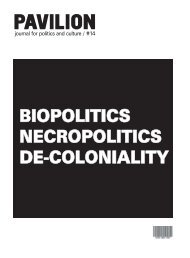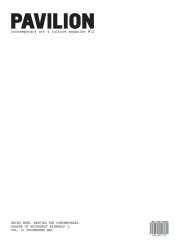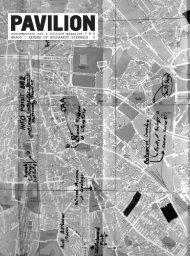Download pdf version of issue no. 16 (4 Mb) - Pavilion
Download pdf version of issue no. 16 (4 Mb) - Pavilion
Download pdf version of issue no. 16 (4 Mb) - Pavilion
Create successful ePaper yourself
Turn your PDF publications into a flip-book with our unique Google optimized e-Paper software.
From Contemplating To Constructing Situations<br />
[28]<br />
by Răzvan Ion<br />
The morality <strong>of</strong> the citizen resides in his<br />
considering that the collective security is<br />
more important than any survival whatsoever.<br />
If the moral <strong>no</strong>w is the one <strong>of</strong> pleasure,<br />
<strong>of</strong> the happiness <strong>of</strong> individuals, then<br />
survival lies under a question mark.<br />
Should <strong>no</strong>thing more be left <strong>of</strong> the citizen’s<br />
morality, should we be devoid <strong>of</strong> the<br />
feeling that we ought to be able to fight in<br />
order to keep your chances for pleasure<br />
and happiness, then we are both shiny<br />
and effete (Raymon Aron). A society <strong>of</strong><br />
spectators empty <strong>of</strong> feedback, invulnerable<br />
to indiscretion and abuse, a pensive<br />
society diminished its chances to build<br />
and progress. The riot, the screaming<br />
voice, with or without the immediate<br />
response from authority is necessary in<br />
the process <strong>of</strong> building up a democracy, a<br />
powerful community under the practice<br />
<strong>of</strong> solidarity. If the suitable soil for a pessimistic<br />
philosophy within history belongs<br />
to the thug, it follows that the glamorous<br />
society can be the condemned one. What<br />
would the world we are living in without<br />
an academic, literary per<strong>version</strong> enabling<br />
us to watch the fights occurring at the theoretical<br />
level between different disjoint,<br />
disruptive concepts, <strong>of</strong> an irregular, <strong>no</strong>nacademic<br />
translation respecting vaguely<br />
etymological texts.<br />
The debate concerning the disruptiveness<br />
<strong>of</strong> concepts that art employs to legitimize<br />
its position, be it self-directed, or<br />
submissive – in Jacques Rancière’s interpretation<br />
– that defines the political art,<br />
on one side, as a policy <strong>of</strong> “auto<strong>no</strong>my”<br />
(the artists’ struggle to be recognized as<br />
practitioners <strong>of</strong> an auto<strong>no</strong>mous discipline,<br />
with the entitlement for a privileged position,<br />
detached within the society) and on<br />
the other side, a policy <strong>of</strong> “hetero<strong>no</strong>my”(<br />
the battle <strong>of</strong> art itself, yet, to fusion with<br />
the social reality, to consume the society<br />
as a compliant material that can be<br />
organized according to artistic conventions)<br />
is a protracted process. Or as he<br />
himself <strong>no</strong>tes, “a critical art is (…) a precise<br />
negotiation (…) this negotiation must<br />
hold on to some <strong>of</strong> the tension pushing<br />
the aesthetic experience towards the<br />
reconfiguration <strong>of</strong> collective life and to<br />
some <strong>of</strong> the tension pulling out the force<br />
<strong>of</strong> aesthetic sensitivity from different<br />
realms <strong>of</strong> the experience, as well as the<br />
eternal undulation <strong>of</strong> the artist to be<br />
sometimes inside the social, sometimes<br />
outside it, according to the benefits/contexts,<br />
it introduces the idea <strong>of</strong> a discontinuity<br />
alongside the social which permits<br />
the creation <strong>of</strong> ruptures.”<br />
The plea for built-in social value <strong>of</strong> art is<br />
complicated, unless one presumes it<br />
from the start as being true. The implications<br />
<strong>of</strong> art are very unfathomable and, up<br />
to a certain extent, art can be safeguarded<br />
in terms <strong>of</strong> other values, such as,<br />
among others, its utility, its sovereignty,<br />
its aesthetic and its message, however,<br />
when art itself conflicts with some <strong>of</strong><br />
these values, some <strong>of</strong> the most shattering<br />
questions emerge.<br />
What do we need today? A basic state? A<br />
state <strong>of</strong> equalities? A post-state? Where<br />
does the role and methodology <strong>of</strong> art<br />
intercede? Can it be a tool for struggle,<br />
progress, debate?<br />
Should modern art be the answer, then<br />
the question is how can capitalism be<br />
made more beautiful? Yet, modern art is<br />
<strong>no</strong>t just about beauty. It is also about<br />
function. Which is the function <strong>of</strong> art in the<br />
disastrous capitalism? Contemporary art<br />
feeds with the crumbs <strong>of</strong> the massive<br />
wealth redistribution and “on a large<br />
scale from the poor to the wealthy, made<br />
through an ongoing downward battle<br />
between the classes” (David Harvey).<br />
The production <strong>of</strong> traditional art can serve<br />
as model for the <strong>no</strong>uveau riche, model<br />
designed by the privatization, expropriation,<br />
and speculations. Certainly, within<br />
the art system there is exploitation, there<br />
are also exploited workers (artists).<br />
Political art through the institutions that it<br />
creates can make a new model <strong>of</strong> social<br />
order because it has already generated<br />
an exploited and practised model (Boris<br />
Groys). As Hannah Arendt <strong>no</strong>ted, we<br />
need <strong>no</strong>t create a new class, but rather to<br />
reject all classes. We should understand<br />
the artistic space ca a political one<br />
instead <strong>of</strong> representing political situations<br />
from other areas. Art is <strong>no</strong>t detached from<br />
politics, its politics resides in its production,<br />
its distribution, its perception.<br />
Should we consider this for a fact, perhaps<br />
we will surpass the flatness <strong>of</strong> the<br />
representation policy and launch a new<br />
kind <strong>of</strong> policy that is already there, right in<br />
[29]








